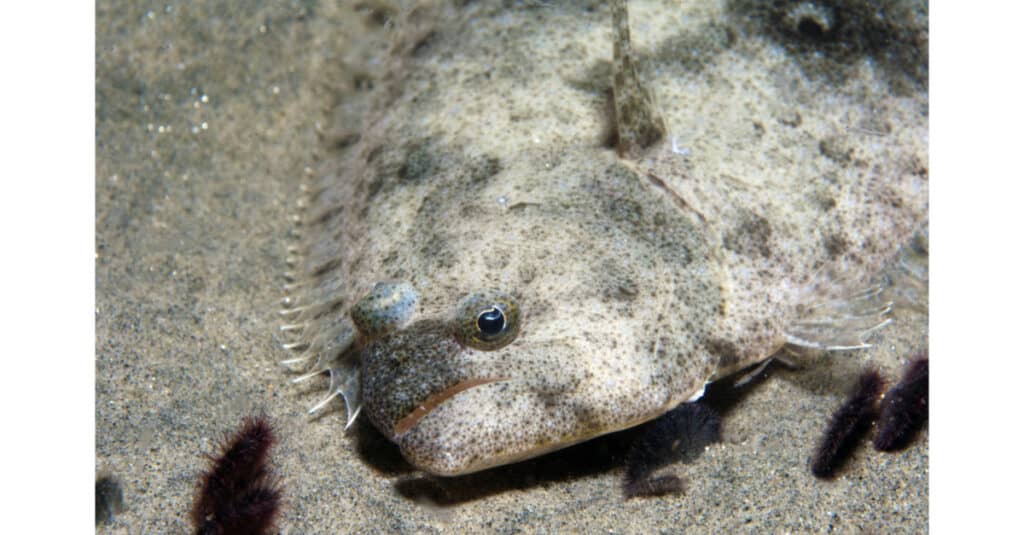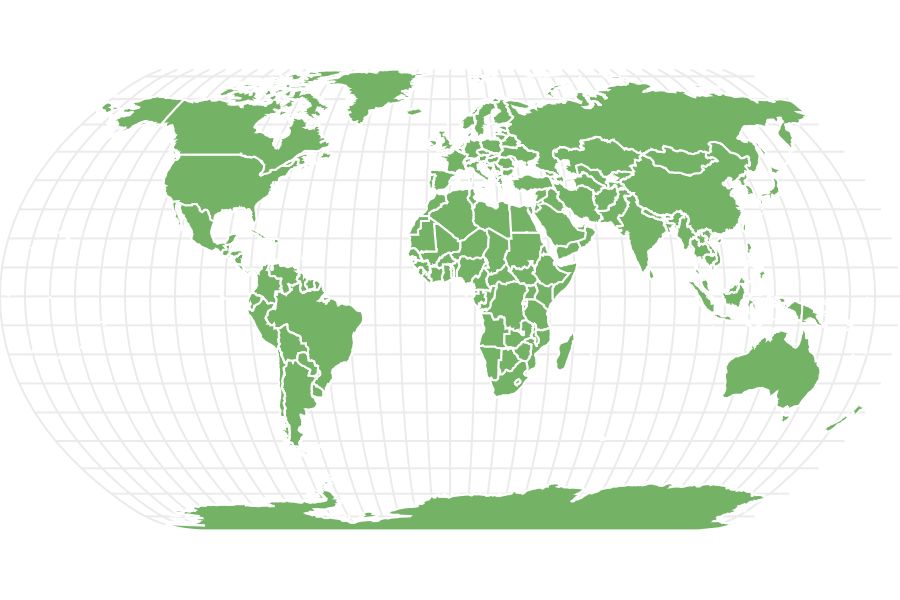Halibut
stenolepis
The word "halibut" is comes from haly meaning "holy" and butte meaning flat fish due to its popularity on Catholic holy days.
Advertisement
Halibut Scientific Classification
- Kingdom
- Animalia
- Phylum
- Chordata
- Class
- Amniota
- Order
- Pleuronectiformes
- Family
- Pleuronectidae
- Genus
- Hippoglossus
- Scientific Name
- stenolepis
Read our Complete Guide to Classification of Animals.
Halibut Conservation Status
Halibut Facts
- Prey
- Adult halibut eat other halibut, octopus, crab, hermit crabs, sand lance, salmon, lamprey, sculpin, cod, pollock, herring, and flounder.
- Name Of Young
- Larvae
- Group Behavior
- School
- Fun Fact
- The word "halibut" is comes from haly meaning "holy" and butte meaning flat fish due to its popularity on Catholic holy days.
- Estimated Population Size
- The Atlantic halibut is listed as Endangered on the IUCN Red List, with biomass at only 3 percent of its target level according to NOAA.
- Biggest Threat
- Overfishing
- Most Distinctive Feature
- They have eyes on one side of their heads, usually right-facing.
- Distinctive Feature
- Halibut have flat bodies.
- Other Name(s)
- Small halibut are called butts and chickens, medium-sized halibut are called turkeys, and big halibut are called barn doors.
- Gestation Period
- 12 - 20 days
- Average Spawn Size
- Females lay 60,000-4 million eggs depending on their size and weight as well as their species.
- Habitat
- Artic Ocean, North Pacific Ocean, North Atlantic
- Diet
- Carnivore
- Lifestyle
- School
- Favorite Food
- These predatory fish will eat any fish they can catch, including other halibut.
- Common Name
- Halibut
- Special Features
- These flatfish have eyes have eyes on one side of their heads. Unlike flounder, which have left-facing eyes, their eyes are usually right-facing.
- Location
- Artic Ocean, North Pacific Ocean, North Atlantic
Halibut Physical Characteristics
- Color
- Brown
- Black
- White
- Green
- Skin Type
- Scales
- Venomous
- No
- Aggression
- High
View all of the Halibut images!
Halibut Summary
The halibut is a type of flatfish or flounder, with the common name “halibut” referring to any one of three flatfish species. The Atlantic halibut is the world’s largest flatfish species, but it has been overfished. Halibut is one of the main fish traditionally used for making fish and chips. Historically, it has been an important food source for Canadian First Nations and Alaska Natives.
5 Halibut Facts
- All halibut are flounders but not all flounders are halibut, although some flounders are called halibut.
- Like many other flatfish species, they have eyes on one side of their heads, usually right-facing.
- They are difficult to smoke or grill due to their low fat content.
- Halibut cooking methods are boiling, deep-frying, or grilling.
- Atlantic halibut are endangered due to overfishing.
Classification and Scientific Name
Halibut are members of the class Actinopterygii of the ray-finned fishes and the order Pleuronectiformes which includes other flatfish such as flounder, turbot, sole, plaice and fluke. Their family is Pleuronectidae of the righteye flounders or right-facing flatfish, which contains 24 genera and 64 species. The pronunciation of halibut is hal-i-but. The word “halibut” is comes from haly meaning “holy” and butte meaning flat fish due to its popularity on Catholic holy days.
Halibut Species
There are three species of halibut. They belong to the genera Hippoglossus and Reinhardtius in the family Pleuronectidae of which the right-eye flounders or righteye flatfish are members:
- Atlantic halibut (Hippoglossus hippoglossus), which lives in the North Atlantic
- Pacific halibut (Hippoglossus stenolepis), which lives in the North Pacific Ocean
- Greenland halibut (Reinhardtius hippoglossoides) which lives in the northern Atlantic, northern Pacific (northeast and northwest), and Arctic Oceans
Appearance
Halibut are known for having a large size. Their top side is dark brown, while they have a white or off-white underbelly. Atlantic halibut can also be blackish or green on their eyed side, while Pacific halibut are greenish-brown and smaller. The Greenland halibut (also called Greenland turbot) is a speckled brown color with a lighter-eyed side, and its left eye does not completely migrate but stays in the center. Halibut’s scales are so small that they are invisible to the naked eye. Their eyes are right-facing. When they are born, their eyes are symmetrical but start migrating to the right side in a process regulated by their thyroid glands, and when the skull is fully ossified, the eyes are set. Their flat bodies suggest that they are strong swimmers and can swim vertically, although they usually swim sideways.
The Atlantic halibut is the largest and heaviest flatfish. It can reach 15.4ft long and 705 lbs, while other species can reach a weight of almost 500 lbs, a length of 8 ft and a width of 5 ft. Most of the largest halibut are females. The largest Atlantic halibut caught was about 700 lbs and caught in Massachussetts, while a 482 lb Pacific halibut was caught in Alaska in 2014. Atlantic halibut females tend to weigh 100-150 lbs, while Greenland halibut weigh 25 lbs. Small halibut are called butts and chickens, medium-sized halibut are called turkeys, and big halibut are called barn doors.

Halibuts are large flatfish with right-facing eyes
©205868233/Shutterstock.com
Halibut vs. Flounder
Flounders include halibut, turbot, sole, plaice, and other flatfish. Other fish species which are called halibut but are flounders are spotted halibut, Indian halibut, California halibut, and shotted halibut. The easiest way to tell halibut from flounder is size, as halibut are much bigger than flounder. They also differ in physical features. Halibut are long and diamond-shaped as opposed to short and round, and have slightly forked, pointy tails as opposed to rounded tails. They are longer than flounder, even if they are otherwise small. Flounders have right-facing or left-facing eyes, whereas halibut’s eyes are almost always right-facing. Halibut live farther north than other flounders and the taste is firmer and meatier than flounder.
Distribution, Population, and Habitat
Halibut are marine fishes. The Atlantic halibut has a depth range of 200-6,600 ft, the Pacific halibut has a depth range of 600-1,499 ft, and the Greenland halibut has a depth range of 1,600–3,300 ft. They live on the bottom of the ocean floor. All three species live in temperate waters, while the Greenland halibut also lives in arctic waters. The Atlantic halibut is listed as Endangered on the IUCN Red List, with biomass at only 3 percent of its target level according to NOAA.
Where to Find Halibut and How to Catch Them
You can find halibut in the north Atlantic, north Pacific, and Arctic oceans. They tend to be 40-80 ft deep while they are feeding. The circle hook is the best fishing line method for catching them, while the best bait is fresh herring, salmon bellies, or geoduck clams.
Predators and Prey
Halibut have a carnivorous diet and are predatory fish. They eat any fish or other aquatic animal they can fit into their mouths. They are also cannibalistic. It is at the top of the food chain in most ecosystems. However, the Atlantic halibut is endangered due to overfishing.
What Do Halibut Eat?
Larval halibut eat zooplankton. Juvenile halibut eat small crustaceans and other bottom-dwelling animals, while adult halibut eat other halibut, octopus, crab, hermit crabs, sand lance, salmon, lamprey, sculpin, cod, pollock, herring, and flounder.
What Eats Halibut?
Sea lions, killer whales, and salmon sharks are a few of the halibut’s natural predators. Humans also eat halibut.
Halibut Reproduction and Lifespan
Females are larger than males due to laying eggs, of which they can lay between 60,000-4 million depending on their size and weight as well as their species. They reproduce by spawning, with males releasing sperm onto the eggs as they swim by. Females are batch spawners and release several batches of eggs each year. All three species spawn during the winter in the deep water, near the ocean floor. They reach sexual maturity at 8-12 years depending on the species. Their lifespan is 21-50 years. Halibut over 25 years old are rare, but the oldest on record was 55 years old. The eggs hatch in 12-20 days and the larvae stay near the surface of the water for 6 weeks before going to the ocean floor.
Halibut in Fishing and Cooking
Halibut is a popular food and sport fish. It is boiled, baked, deep-fried, or grilled. It has a firm, meaty texture and a lean, mild, never fishy flavor that is delicious. All three species are healthy, providing a great source of lean protein as well as selenium. The fish is used in many different types of recipes. However, it is expensive because it is rare, with the price going up due to high demand and high labor. The price of a whole halibut at your local fish market can be $20-40 a pound.
View all 104 animals that start with HHalibut FAQs (Frequently Asked Questions)
Where is halibut found?
The northern Atlantic, northern Pacific (northeast and northwest), and Arctic oceans.
Is halibut a good fish to eat?
Yes. It is delicious and healthy.
Is halibut an expensive fish?
Yes, because of the high demand and high labor involved. Also, Atlantic halibut is overfished.
Is cod or halibut better?
Both are healthy and both are used as traditional fish for fish and chips recipes. However, halibut is healthier.
What does halibut fish taste like?
Firm, meaty, lean, and mild, but never fishy.
How do you cook halibut?
You can boil, bake, deep-fry, or grill it halibut.
What are the diferences between haddock and halibut?
Haddock and halibut differ in appearance, size, diet, distribution, predators, reproduction, and lifespan.
Thank you for reading! Have some feedback for us? Contact the AZ Animals editorial team.
Sources
- Fishing Booker / Accessed April 4, 2022
- Britannica / Accessed April 4, 2022
- Kidddle / Accessed April 4, 2022
- Wikipedia / Accessed April 4, 2022
- The Spruce Eats / Accessed April 4, 2022
- Talk About Fish / Accessed April 4, 2022
- California Academy of Sciencies / Accessed April 4, 2022
- NOAA Fisheries / Accessed April 4, 2022
- Wild Rivers Fishing / Accessed April 4, 2022
- Experience Ketchikan / Accessed April 4, 2022
- NOAA Fisheries / Accessed April 4, 2022
- NOAA Fisheries / Accessed April 4, 2022
- NOAA Fisheries / Accessed April 4, 2022
- Smarter Homemaker / Accessed April 4, 2022
- Foods for Anti-Aging / Accessed April 4, 2022


















